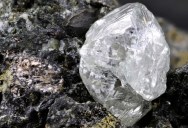New Discovery By De Beers Should Make Finding Diamonds A Lot Easier
by Trisha Leigh

Diamonds are notoriously difficult to locate and also to get out of the ground (and sell legally).
And while this new discovery may not help with the second two hurdles, it is supposed to make locating diamond deposits quite a bit more simple.
That’s because it is relatively easy to find another gem that often shows up in and near diamond deposits.
“Diamond producers sometimes wish they were mining gold, copper, or some other raw material, because nothing is as complicated as finding an mining diamonds.”

Previously we’ve searched for kimberlite instead, but it’s not all that easy to find, either – and often it’s not in that close of proximity to the diamond deposit in question.
Olivine, though, is a different story.
It contains varying concentrations of magnesium and iron, and when the magnesium is higher, it’s usually a sign that diamonds are closeby.
This is because when olivine is high in iron, that means melt has penetrated the mantle, altering the rock’s composition and eliminating diamonds in the process.
Diamonds survive when those higher temperatures don’t exist, and the magnesium hasn’t changed, either.

De Beers provided some financial backing, so got early access to the results.
“Our study shows that diamonds remain intact only when kimberlites entrain mantle fragments on their way up that haven’t extensively interacted with previous melt. The great thing about this new method is not only that it’s simpler, but also that it finally allows us understand why the previous methods worked.”
I’m honestly not sure whether this is a good thing or a bad thing for the world economy.
But I’m sure it’s good for De Beers.
If you think that’s impressive, check out this story about a “goldmine” of lithium that was found in the U.S. that could completely change the EV battery game.
Categories: STORIES
Tags: · diamonds, diamonds and kimberlite, kimberlite, magnesium, science, single topic, top

Sign up to get our BEST stories of the week straight to your inbox.




